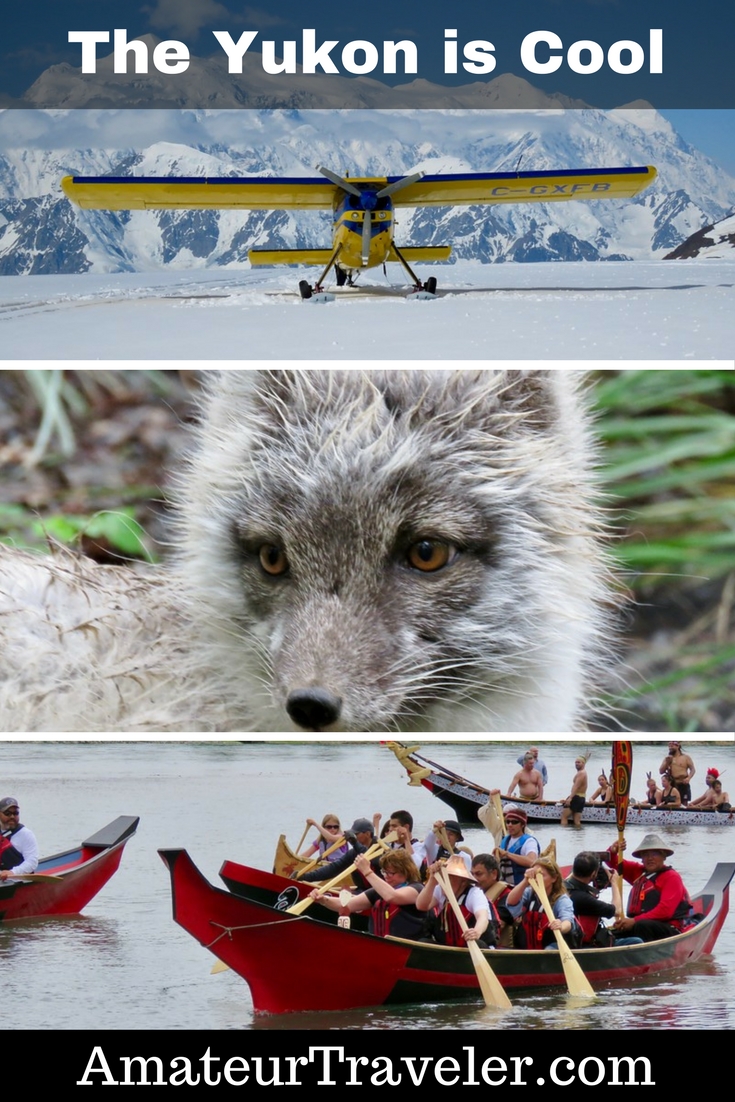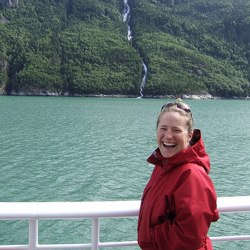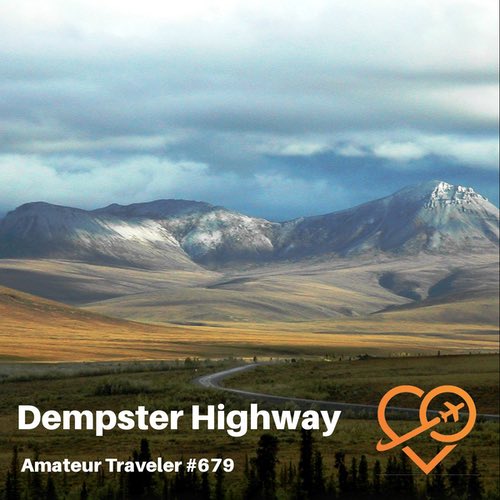I expected the landing of the plane to be rough for some reason, probably because we were landing on a river of ice 2,000 feet thick. But instead, when the skis touched down it was the softest landing I have ever experienced. The plane came to a stop on the largest non-polar icefield in the world. The Yukon is a cool place.
I was a bit surprised to find myself in the Yukon a few weeks back, since until the Wednesday before I had no plans on being there. But when you open your email as a travel blogger, interesting things may happen. In this case, the interesting thing was an invitation to join a press trip at the last minute with Yukon Tourism.
Table of contents: ()
Klondike Gold Rush
If you are not familiar with this corner of Canada, think of the Yukon as Canada’s own version of Alaska. The comparison is not just that they are connected physically, but also that the Klondike Gold Rush and Alaska’s Nome Gold Rush happened just 3 years apart in 1896 and 1899 respectively. Alaska was on the route that most miners took to the Yukon and then the place that they left it for.

Arctic Fox – Yukon Wildlife Preserve
More Moose than People
The population of the Yukon is just 38,000 people, less now than the 40,000 miners who eventually made it to Dawson City during the gold rush. The population of Whitehorse is almost back to the 30,000 people it had in 1900. Today there are 5x as many caribou and 2x as many moose as there are people in the Yukon. That’s not a lot of people for an area larger than every state in the United States except Texas and Yukon’s neighbor Alaska.

Musk Ox – Yukon Wildlife Preserve
Yukon Wildlife Preserve
Our first stop was to visit some of the Yukon’s non-human residents at the Yukon Wildlife Preserve just outside of Whitehorse. This preserve has only animals that can be found in the Yukon including bison, caribou, mountain goats, tin horned goats, deer, arctic foxes, moose, elk, eagles and musk oxen.

Bald Eagle – Yukon Wildlife Preserve
The preserve covers 700 acres and you can walk it or get a guided tour. I highly recommend a tour as you will learn much more about the animals. The typical tour is 2 hours. We were on a custom tour from Who What Where Tours in Whitehorse and our guide Leona was also very knowledgeable.

Bison – Yukon Wildlife Preserve
The weather in Whitehorse in July is warm enough for shirt sleeves so many of the animals looked pretty motley as they were in the process of shedding their winter coats. In the winter the area can drop down to 40 below (on both Celsius and Fahrenheit), so it is good for an animal to have a very warm coat. The Yukon is a very cool place.
Route of the Gold Rush
During the Klondike gold rush, one of the routes to Dawson and the goldfields was taking a boat to Skagway in Alaska, caring your supplies and over the Chilkoot pass, building a boat or raft, and floating down the Klondike River through what is now Whitehorse. The city of Whitehorse is named after a series of rapids just upriver. These rapids were so swift and so dangerous that the local head of the Mounties at the time of the gold rush, Major General Sir Samuel Benfield Steele, required boats be unloaded and women and children removed before attempting to shoot the rapids.
With the addition of The Whitehorse Dam on the river, the rapids are mostly gone now and that section of the river is now an easy float trip. We rowed a voyageur canoe (a 15 person canoe of the type used to explore much of Canada) through Miles Canyon lined with basalt columns. Our trip was run by local outfitter Up North Adventures.

Adäka Festival – Kevin Barr & Boyd Benjamin
Adäka Festival
Our trip was timed for the week of July 4 because of a local First Nations festival. The name of this festival is Adäka which translates to ‘coming into the light’. I learned that 200 years ago a member of one of the First Nations prophesied about a 200-year period of darkness for the native peoples in North America. As those days come to an end, festivals like this celebrate and resurrect some of the history, art, and crafts of the native peoples.
We visited the festival on three successive nights. On the first night, we saw two musical groups. Both groups were entertaining, although in quite different ways.
The first was a Bluegrass duo – Kevin Barr & Boyd Benjamin.

Adäka Festival – Northern Cree Singers
The second was the Northern Cree Singers who sang more traditional First Nations melodies accompanied by drums. But this group sometimes use less traditional lyrics like why they unfriended you on Facebook. The Northern Cree Singers would’ve been more interesting to my ears if there had been as much variety in their melodies as there was in their lyrics. But what do I know, they were a hit at the Grammys.

Adäka Festival – Twin Flames
On the second night, we saw the performance of what I can best describe as First Nations folk singing. The husband and wife group Twin Flames sang haunting melodies in English, French, and Inuit on a variety of themes. The festival coordinators knew they wanted to invite Twin Flames after hearing their song Porchlight which was dedicated to a man whose sister had disappeared. It was news to me that First Nations women disappearing is a serious problem. (For more information on this issue see the Campaign on Missing and Murdered Inuit Women)
The third night of the festival was the closing ceremonies which was highlighted by performances in both the Tlingit language and in Maori. A group of Maori had been invited to celebrate the common bond of indigenous peoples. This portion of the program was almost a sing-off between the two groups. Not a word of English was spoken or sung.

Adäka Festival – Watercraft
The other big feature at this year’s festival was the creation of four native watercraft: a dugout canoe, a birch bark canoe, a sealskin kayak, and a moose skin boat. The moose skin boat was the one that was new to me. It was a sort of temporary boat that was used at the end of the fur trapping season to bring home the pelts. Some of the knowledge of how to build these boats had been lost and needed to be rediscovered from the historical record. On the last day of the festival, the watercraft were dedicated and then launched with great ceremony.
White Pass and Yukon Route Railroad
The same Canadian Mountie superintendent who put on who put limits on the rafting down the Yukon River, Major General Sir Samuel Benfield Steele, probably saved countless lives by requiring miners who entered the Yukon Territory during the gold rush to bring a years worth of supplies, roughly a ton of goods.
Most miners hauled their goods up the Chilkoot Pass between Skagway Alaska and Whitehorse. It usually took around 30 trips either by yourself or with the help of first Nations porters. Miners were met at the border by Mounties with a Maxim gun emphasizing their insistence on some of these rules are being followed.
Miners would haul their goods down to Bennett Lake where they built boats from local timber to make the rest of this trip on the Yukon River, including the Whitehorse Rapids. They hauled their supplies and build their boats in winter. When the Yukon River ice broke on May 29, 1898 7,000 boats headed out from the lake towards the goldfields.
In 1900, the White Pass and Yukon Route Railroad was completed to Carcross that made the trip much easier. You could take the railway to an awaiting paddle wheeler at Carcross.
With the decline of mining and the opening up of the Alaskan highway, the train stopped running in 1982 and the last paddle wheeler, the SS Klondike, was retired in 1955 shortly after a road was finished between Whitehorse and Dawson. The SS Klondike is now a museum in Whitehorse.
These days the train has reopened it’s route from Skagway to Carcross but is filled with tourists instead of miners. Most of the tourists are doing a day trip from their cruise ship up the inland passage of Alaska.
We rode the train from the Canadian border down to Carcross (originally named Caribou Crossing). It is a beautiful route. At the top near the pass, you ride by lakes and granite outcroppings show the signs of ancient glaciers. The train stops at Bennett Lake where there is a small museum in the train depot. It shows a video about travel during the time of the gold rush. There’s also a diorama to give you an idea of what a ton of goods, a years supply, looks like.
From Bennett Lake, you can hike up the Chilkoot Trail over the top to Alaska, or just up the hill to see the church which is one of the only parts of the once thriving town of Bennett. Some fortunes were made not in the goldfields but by providing services for the gold miners. One such successful entrepreneur who ran the Arctic Restaurant and Hotel (and brothel) in the area was a German immigrant Frederick Trump, the grandfather of President Donald Trump.
Bring bug spray, even if you’re only doing the short hike up to the church and especially if you plan on doing the longer hike along the Chilkoot Trail either to or from Alaska as the mosquitoes were ravenous.
Carcross
The town of Carcross surprised me. I expected the town where I could buy a “my grandparents went to the Yukon and all I got was this lousy T-shirt” souvenir. You can probably get that T-shirt there but they’re also some more interesting shops with First Nations crafts. We visited the studio of local woodcarver Keith Wolfe Smarch and who makes his living carving totem poles. The area also has some great smelling restaurants and some tasty ice cream shops.

woodcarver Keith Wolfe Smarch
We had a chance to talk to Search about his wood carving business. He explained to us the meaning of the colors in the restrictive pallet used by the local tribes (Red for life, Black for protection, Blue for wealth and White for peace). He also explained the many uses for poles in the local culture. There are clan pools, story poles, memorial poles, debt poles (I put up a pole in your yard saying you owe me a debt), humility poles, mortuary poles (with someone’s ashes in the pole), and potlatch poles. These poles would not originally have been found in the interior of the Yukon which lacks the large trees needed for their production but come from the coastal tribes.
Flightseeing in Kluane National Park
The highlight of the trip was definitely the flightseeing tour of the ice fields in Kluane National Park with Icefield Discovery. Landing on the glacier was a singularly wonderful experience, but in all honesty, the best views were the flying portion of the trip.
You could see the lateral moraines on the glaciers that marked where two glaciers combined.
You could see canvases and bright bright blue pools of water on the glacier.
You could see the rugged mountains in the area including the second tallest in North America, Mount Logan.
It is a dynamic environment where, in 2016, virtually overnight the landscape was reshaped as the glaciers changed their course and started draining into a different river in an entirely different direction.
Conclusion
I’m still a bit intimidated by winter in the Yukon and those 40 below temperatures. The Yukon is cool, but that may be a bit too cool for me. But I would love to explore more of the Yukon.
I never had a great desire to drive the Alaskan highway, but now that I have been on some of it and seen this Yukon stretch of it, driving it has gone on my to do list.

Glass Blowing Studio – Whitehorse
I was surprised by the number of people I met who had moved to Yukon and from places like Germany, Tobago, or England. They told me they were drawn by the open spaces and they were drawn by the outdoor activities. Yukon’s latest pioneers are coming for a different kind of riches.
+Chris Christensen | @chris2x | facebook
5 Responses to “Things to do in Whitehorse Yukon in Summer”
Leave a Reply
Tags: article, featured, kluane national park, video travel podcast, whitehorse, yukon territory



















 Travel to the Yukon Territory – Episode 573
Travel to the Yukon Territory – Episode 573 Travel to the Yukon Territory in Canada (and nearby Alaska) – Episode 198
Travel to the Yukon Territory in Canada (and nearby Alaska) – Episode 198 Canada’s Dempster Highway – Episode 679
Canada’s Dempster Highway – Episode 679 Vancouver In The Summer – 11 Outdoor Activities To Do
Vancouver In The Summer – 11 Outdoor Activities To Do


Yukon Wildlife Preserve Lindsay Caskenette
Says:August 3rd, 2017 at 12:24 pm
Thank you for including the Yukon Wildlife Preserve in your visit and blog! However, please note a correction, the Yukon Wildlife Preserve has thinhorn sheep and rocky mountain goats!
chris2x
Says:August 3rd, 2017 at 11:39 pm
Oops, I heard wrong
lakshmi
Says:August 9th, 2017 at 2:28 am
Yakon sounds like an interesting place to visit. Am sure you had great fun after all unplanned trips are just amazing.
Milan Michel
Says:June 28th, 2018 at 12:17 am
Nice images…
chris2x
Says:June 28th, 2018 at 8:48 am
thanks!